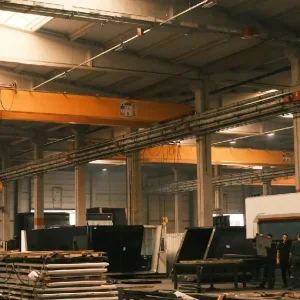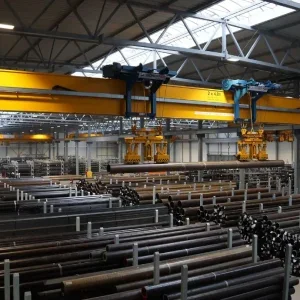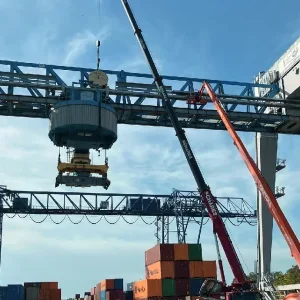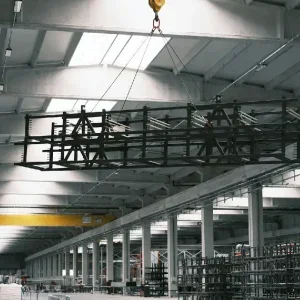For nearly a decade a major expansion project has been widening the famous Panama canal, primarily by adding new larger locks. When complete next year the ships coming through will be up to 50% wider than before, deeper in draught and longer than the previous "Panamax" limits. Post- or New Panamax ships are based on lock dimensions of 427m in length, 55m beam, and 18.3m depth of water. For container vessels that can mean cargoes of up to around 13,000 standard container twenty-foot equivalent units (TEUs), almost treble current 5000 capacities.
These relative giants impose new demands on the ports where they are loaded and unloaded; deeper water is required and longer jetties, larger yard storage and better transshipment facilities. Above all of course, they require bigger cranes to both clear their greater height and to reach across many more rows of containers perhaps 19 or 20 against 12-14 before. If possible they need to be faster too, to shift much greater numbers of containers and turn the vessels around in good time.
Inside the ports yard handling needs more of the gantry and container lifting cranes that stack and organise the storage spaces, and then load the trains or trucks coming in to deliver units or move them out.
Many of the US ports have been making investments in recent years, and particularly the bigger ones like the huge port complex of New Jersey and New York, where five major terminal operate, Charleston in South Carolina, Savannah in Georgia, Baltimore near Washington DC, Norfolk, Virginia and Miami. Further south the Mexican Gulf ports have also been upgrading, notably Houston in Texas and the port of New Orleans.
Further afield there are upgrades too for ports in Latin America, in Mexico, Brazil, Uruguay and others. Key suppliers include Liebherr for ship-to-shore cranes, yard handling equipment and, increasingly, mobile harbour cranes, Konecranes in Finland also supplying STS units and rail mounted gantry cranes for the yards, and with the greatest numbers, China’s ZPMC cranes from Shanghai Zhenhua Heavy Industries has supplied STS cranes.
The investments and changes are not driven simply by the bigger sizes of ships but by an entire complex of potential changes in trade patterns and competition between ports battling to handle imports and exports, itself affected by the way in which the huge area of the US and its major population zones are serviced by transport links and developments in rail, and highways. Economies of scale for the shipping lines are also important.
"One important advantage for the shippers being able to make as few calls as possible when planning their routes" says Dustin Burke, principal at analysts the Boston Consulting Group which released a report on the canal impact "Wide open: Panama Canal Is Redrawing the Logistics Map". "They tend to travel north-south or vice versa and reducing calls and dwell times is a key factor."
Larger ships also have better fuel economy. Taken together this will favour larger ports with the better offloading capabilities he suggests. Transshipment to smaller vessels is part of the mix.
The BCG report analysed US container trade from next year and suggests a likely shift will be seen in the percentage of goods coming through the big West Coast ports like Long Beach, Seattle and San Francisco. These feed much of the western and central US, including cities like Chicago, via major rail links particularly. "The West will not see a decline but slower growth is likely" he says. Meanwhile the report suggests a 10% increase in trade is possible on the east coast perhaps more. An additional factor pushing expansion for east coast ports is bigger ships coming via the Suez canal, which is likely to continue. These can be even bigger than the New Panamax sizes with up to 22 rows of boxes.
All this has been driving new port investments, some already completed and others in progress.
One of the most significant is a major reconfiguration of the Bayonne port Global terminal, one of five terminals in the New Jersey/New York port complex which services one of the largest markets in the US with a catchment of around 30M.
The terminal, appropriately operated by Global Container Terminals, is the only one on the outside of the Kill Van Kull, the main channel passing into the large Newark and Port Elizabeth area. Sitting on the end of the Bayonne peninsula it is the only terminal unaffected by a headroom restriction for ships passing under the famous Bayonne bridge which connects New Jersey to Staten Island.
A $1.2bn project is underway to reconfigure the bridge which will lift its road deck 20m to give a navigational clearance of 66.1m by late 2017, but until than GCT has a significant competitive edge says the GCT project manager for new terminal Rich Ceci. "We are the only terminal that will take the big Suez and new Panama ships" he says. Water draft is being increased to 15.2m and a new marine to rail transshipment zone is part of the works.
The project involved eight new ship-toshore cranes, six from from China’s ZPMC and two from from Germany’s Liebherr Container Cranes with manufacture based in Ireland. The latter, and two of the Chinese cranes, are for the bigger vessels he says with a 62m outreach and a height over deck of 42m. "We bought the ZPMCs in a four plus two deal, and took the last ones in a bigger size."
Apart from STS cranes, the new yard will feature some of the latest in automation technology with twenty rail mounted gantry cranes from Konecranes, operated remotely from a central control centre and with special stacking and location software for the container inventory. Ten RMGs will service the shipside and ten the landside.
The equipment and logistics software allows the yard to use the space more efficiently, with fuller use of the up to five deep container stacks but shorter dwell times. "You can shuffle faster" says Ceci. The operation, which has been going for around a year, is semi-automated he says along the lines of Antwerp in Belgium, with final loading of trucks carried out manually for safety reasons. Containers are also be moved around the new yard by 17 smaller manned rubber tyred gantries supplied by Terex.
Operator GCT also has one of the four interior port terminals he says which will also upgrade in time for the bridge raising. Other terminals are also upgrading for the bridge. One of the largest is the Maher Terminal in Port Elizabeth which has currently got four large STS cranes on order says Trevor O’Donoghue at Liebherr. These will have a waterside outreach of 68.6m, backreach of 22.9m and a lift height under the spreader of 46.8m. Maher has also been increasing its capacities in yard handling and recently saw delivery of eight new electric drive straddle carriers from Konecranes. They can lift 40t in single container operation and 50t in twin-twenty operation, to stack up to 3 containers high.
Port Newark terminal has also upgraded with three new super-post-Panamax capacity cranes ordered from ZPMC which arrived summer 2014. The terminal is also investing in rubber-tyred gantries, a change from its current operations using reachstacker equipment, it says.
Other major ports on the US east coast have been expanding too. Biggest is Savannah, Georgia with a large catchment in the fast growing south-east. The port has been almost continuously expanding its capacities over the last decade, primarily using Konecranes’ STS equipment. A four crane installation was made two years ago and four more are currently in manufacture says the Finnish firm, with delivery late next spring. It will give the port some 20 post-Panamax capable cranes along a 3km long wharfage, as well as nine Panamax size.
"These will be the largest they have with a 152′ (46.8m) height over wharf" says Konecranes chief mechanical engineer Imari Urho. Outreach will cover up to 22 rows of containers.
"We will have to transport them semierected because of a bridge before the harbour and the jack them to full height once on the rails" he says.
Savannah also operates a huge fleet of rubber-tyred gantries which has been expanded to over the last two years with 20 units from Konecranes.
The port currently handles up to 9500 unit vessels but is deepening its water to 47′ (14.5m).
Just north the port of Charleston, under the South Carolina Ports Authority has deeper water, currently 45′ but with an ongoing project to deepen it to 52′ by 2020, says spokesman for the SCPA. A favourable U.S. Army Corps of Engineers report was received in September.
Even now the port receives "an average of 11 large ships weekly. Our harbor depth allows post-Panamax ships fully loaded with export containers" he says.
Investments also include infrastructure upgrades and "$24.9M in terminal equipment last year, including $5.3M towards two new ZPMC super-post- Panamax container cranes." In total the port will invest $35 million in the design, purchase and integration of the cranes for its Wando Welch Terminal and related terminal infrastructure he says. The cranes provide 155′ (47.7m) height under the spreader bar and will be delivered next June.
North from here is the Virginia port complex with two major terminals, Norfolk International Terminals and the Virginia International Gateway. Both of these were readied for Panama 2016 shipping some time ago says port spokesman Joe Harris.
"We have a 50′ (15.4m) depth of water here" says Harris "and a significant number of cranes capable of handling the bigger ships. Norfolk Terminals for example has 14 super-post-Panamax class quay cranes from China’s ZPMC and is capable of handling 12,000-14,000 TEU vessels. "Six of those have a 22 container reach and the rest are 20 containers wide," he says. The Virginia Gateway was developed as an automated terminal in 2007, the first in the US, with Bayonnne’s Rich Ceci playing a significant role at the time. APN terminals has sold the facility on since and it is operated on a lease basis by the port authority. It has six ZPMC post-Panamax cranes and "can handle the largest container vessels" says Harris. Other US east cost ports are also investing. In Mobile Alabama, APM Terminals is doubling its super-Post Panamax STS capacity with two new ZPMC cranes to complement two already in place.
"We have been ready for the bigger ships for several years" says Alabama state port authority spokeswoman, Judith Adams. Other ports buying cranes include Tampa in Florida, which currently has a $24M project for installing two ZPMC post- Panamax cranes with a 19 row outreach capacity and As well as the east coast the Gulf ports are also expanding, the most significant being Houston and New Orleans. The former, servicing the US biggest state (excluding Alaska) is one of the US’ largest ports and this year handled over 2M TEUs. Containers are primarily handled at two facilities, the 1970s built Barbours Cut and the newer Bayport, first opened in 2007 but with continuing expansion for the next decade. Bayport uses mainly ZPMC cranes, four of them able to reach across 22 rows. The older facility is being substantially renovated, its small STS cranes replaced with giants; the first four from Konecranes arrived in spring this year and are just going into service says Jeff Davis, chief ports operations manager.
An advantage of the Konecranes, apart from their size – they have a 144′ (44.3m) lift height and 22 row capacity, – is their high technical specification.
The electrically powered cranes have twice the speed of the terminal’s existing cranes and are fitted with "ship profiling" technology. With this, laser detection constantly monitors the status of changing container stacks on board to prevent collisions.
Along with a further three STS large cranes to come, the order yet to be placed, the renovated terminal will double its capacity to over 2M units. To handle these numbers in the yards in both terminals yard operations are mainly done with Konecranes RTGs, some 60 at present between the two, and with more to come. Houston is looking not just at the huge Texas market but beyond into the important mid-West areas, sited between the Rockies and the Mississippi river, believing that it is well placed to transport there as far as Chicago, without having to cross these natural barriers.
Another Gulf port with its eye on the central areas is New Orleans with the potential to transship to Mississippi boats and rail links inland.
The port has recently installed two larger STS cranes from Doosan Heavy Industries in South Korea says Port of New Orleans spokesman Matt Gresham giving a reach of 19 rows. Water depths current allow for 45′ (13.85m) and the port is seeking authorisation for deepening part of the facility to 50′ (15.4m).
"We also have two big RTG’s on order from Konecranes" he says. The new canal capacities will also have an impact on Latin American ports, particularly further south where countries do not have access to the Pacific coastline as some do in central America, with coasts on both oceans.
Some ports here are taking new STS cranes. Liebherr Container Cranes sales manager Trevor O’Donoghue reports orders from some ports such as Mexico’s Puerto de Altamira on the Gulf which is taking a large crane with a 58.3m outreach, and 40m height under the spreader for example.
It is also a market that Konecranes is exploring more says the company’s US marketing manager Jussi Suhonen. There are some differences there he says including a tendency to use higher stacking in the container yards, to a maximum six containers.
Part of the reason is a longer dwell time in many of the Latin American ports, which results from more complex paperwork. Another feature of the Latin American market is a preference in some cases for mobile harbour cranes rather than ship to shore types. German maker Liebherr has had particular success with these types, used singly or sometimes in tandem. "There is greater flexibility using harbour cranes which is useful when port operators do not have sole use of a terminal" says Liebherr maritime cranes marketing manager. He says the larger models, the LH 550, and LH 600 are particularly popular with 75% going to this market.
One recent example is a new post- Panamax crane for Argentina’s capital where the Terminal 5 facility is operated by Buenos Aires Container Terminal Services, part of port developer and operator Hutchison Port Holding) since 2001. "THE terminal has an approach channel with a maximum draft of 9.8ms and a tidal range of 0.9m" says Liebherr "optimal for new big vessel types."
But logistics infrastructure improvement for the port meant the quayside could not keep up, and in September 2013, a new Super-Post Panamax LHM 600, began operation. It has an elongated tower extension for high visibility into deep cargo holds and a tower cabin over 37m up, providing better sight into the ship. In Guatemala, Manabique Logistics is using three of the latest LHM 420s, the latest model with a lifting capacity of up to 124t and a maximum outreach of 48m. These are the first mobile harbour cranes for Puerto Barrios at the coast of the Caribbean Sea.
Due to semi-assembled delivery, it took only one week per crane to become operational after arrival. The mobile harbour crane trio started operation in August 2014. In Costa Rica, Sociedad Portuaria Puerto Caldera has been using a new LHM 550, since the end of 2014, the second mobile harbour crane at the terminal. It also operates an LHM 500 and four LRS 645 reachstackers.
Liebherr has also sold its largest model of all the LHM in a container configuration to Montecon in Uruguay giving capability for 22 container rows, which will allow it to handle Panama route vessels as well as other routes.
The firm says the LHM 800 operator eye level on the crane is above 40m and the fulcrum point is above 36m on the crane which has an outreach of 64m. Hoisting and lowering speed is 120m/minute which allows for up to 45 boxes per hour.






